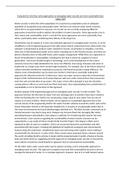Evaluate the view that some approaches to managing water security are more sustainable than
others [20]
Water security is when the entire population of a country has sustainable access to adequate
quantities of acceptably clean and potable water. We live in an insecure water world, however,
where this is not guaranteed for everyone. As a result, we are currently employing different
approaches around the world to address the problem of water insecurity. These approaches vary in
their nature and sustainability, and it is certain that some approaches are more sustainable than
others, particularly when considering their efficacy in the long term.
Desalination may be argued as a more unsustainable approach to managing water security. It can be
simplified to a hard-engineering process that takes away mineral components from saline water; the
saltwater is desalinated to produce water suitable for human consumption or irrigation. Currently,
there are 14,000 desalination plants in the world, including one in the Thames Estuary, and there are
plans to develop more to help with future water supply management. While there are arguments in
favour of desalination’s sustainability, including the fact that it conserves supplies for future
generations, and recent breakthroughs in technology, such as the development of the reverse
osmosis process has made desalination far more cost effective, less energy intensive and easier to
implement on a large scale, there remain huge drawbacks. For example, due to the future advent of
carbon nanotube membranes requiring less pressure and therefore greater energy efficiency, the
relative costs of desalination may increase even further in the future, essentially making this
approach the ultimate techno-fix. Furthermore, there are major concerns about the environmental
impact of this method because of its waste disposal. Left-over water returned from the process has
twice the salt concentration of sea water. This water is then often dumped it near the shoreline,
causing adverse effects on coral reefs and their food webs, thus substantiating how consideration of
sustainability is not at the forefront of this approach.
Another popular hard-engineering approach to managing water security is water transfer. This
approach involves the diversion of water from one drainage basin to another (inter-basin transfer),
either by diverting the river itself or by constructing a large canal to carry water from an area of
surplus to an area of deficit. Water transfer can be argued as a sustainable approach due to the
current success of the engineering itself in the water transfer schemes around the world, such as the
Snowy Mountains Scheme in SW Australia. Despite this, it remains an unsustainable option due to
the many environmental and social disadvantages attached to it. The latter include: continued use of
transferred water may lead to long-term changes may increase flood risk, damaging fish stocks,
spreading diseases and pollution, and acting as a pathway for introducing alien species into new
environments. Such concerns regarding the sustainability of water transfer schemes can be
supported by a case study of China’s South-North Transfer Project. This begun in 2003, and is
expected to take 50 years to complete. Critics are concerned about the uncertainties and risks
associated with the project, including the likelihood of significant ecological and environmental
impacts along the waterways, resettlement issues and worsening water quality, hence making it
unsustainable for the future. In spite of this, there remain many proposed future schemes around
the world, including the Ebro scheme in Spain and the projected water transfer schemes in Russia,
India and North America, suggesting that this approach to managing water security is favoured by
many nations around the world despite its apparent lack of environmental sustainability.
On the other hand, water conservation can be argued as being a more sustainable approach to
managing water security. This approach is hugely concerned with sustainability because it aims to
manage the demand of water. It is a complex approach, however, due to it is multi-faceted nature.





